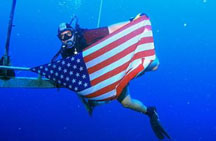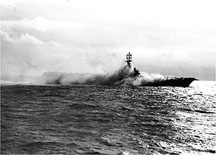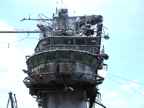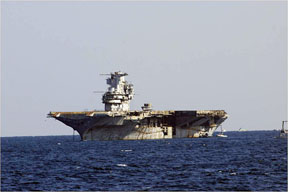|
On the third anniversary of her burial at sea . . . Jewel Of the Emerald
Coast |
Like the Jewel of the Nile in a movie by the same
name, the Jewel of the Emerald Coast is not a precious gemstone. This
jewel is the retired United States Naval Aircraft Carrier CVA-34, the
USS Oriskany, the last Essex Class super carrier of its kind to serve
on active duty. May 17th marks the annual anniversary of the Oriskany's
burial at sea in 2006, now resting in its final berth in 212 feet of water
on the bottom of the Gulf of Mexico 25 miles south of Pensacola, Florida.
Since being sunk, the ship has become a valuable jewel to fisherman, recreational
divers and local merchants on the Emerald Coast.
 Oriskany Battlefield: Bloodiest Battle of the American Revolution. Click Image for a larger view Image Courtesy New York Traveler |
The Navy named the renowned aircraft carrier after a strategic
battle of the Revolutionary War, the Battle of Oriskany where the
Tryson County Militia under the command of General Nicolas Herkimer
defeated the British in the Mohawk Valley, New York on 6 August
1777. Historians credit this battle as key in turning the tide of
the Revolutionary War in favor of the Americans. During her active duty phase the Oriskany, affectionately called The Mighty O by her officers and crew, |
| During October of 1966 the famous comedienne Martha
Raye, also a registered nurse, was aboard the USS Constellation giving
a show when a catastrophic fire broke out on the Oriskany killing
44 officers and men. She immediately offered her services to help
treat the injured seamen, however the Oriskany's commander, Captain
Iarrobino, felt the conditions aboard were too dangerous for Miss
Raye and declined the offer. Although unknown during her operational service, The Mighty O had its own cast of future celebrities. Pilot Alan Sheppard, aboard during the mid-1950s, was destined to become an astronaut for NASA. Aboard during early Viet Nam was the late Admiral James B. Stockdale |
After decommissioning in 1976, the future of The Mighty O remained uncertain for almost three decades. The Navy considered various outcomes such as turning it into a museum or selling it to Japan for a special project, but both projects failed to materialize. The Navy then tried to sell The Mighty O for scrap metal. That too failed so the Navy decided to bid out the ship for the artificial reef program, the first and only US aircraft carrier of its kind to do so. The state of Florida eventually won the bidding among the other Gulf States wanting the ship to be sunk in their waters.
| The Oriskany had to undergo preparation for sinking
both in Corpus Christi, Texas and Pensacola, Florida to ensure nothing
could hurt the environment or injure recreational divers. The US Environmental
Protection Agency required all toxic materials removed such as PCBs,
asbestos insulation, lead based paint and various liquids from 565
separate storage tanks. All surfaces then had to be cleaned by scorching
or by powerful hydro-blasters. With over one thousand separate rooms
in the ship, it took thousands of man-hours and over 8 months to accomplish.
Originally, the salvage plan allotted for 29 tons of waste and 24 semi trailer-truck size dumpster loads |
The state of Florida required all cables, protruding objects and anything else that could injure or trap a diver underwater be removed from the ship. The entire wooden deck and over 200 miles of cable materials containing PCBs had to be taken out. This additional work took more man-hours before the ship could finally be sunk.
After the removal of hazardous materials and the salvage of over 1000 tons of precious metals, The Mighty O left Corpus Christi towed by tug boat over 500 miles across the open waters of the Gulf of Mexico to Pensacola, Florida. There, the ship was rigged for demolition.
|
On 16 May 2006, The Mighty O took her last voyage, towed into the Gulf of Mexico 25 miles south of Pensacola then moored overnight by four huge anchors above her permanent berth. Silently she waited throughout the dark night to fulfill her destiny. The next day, 17 May 2006, an electronic charge sent through ten miles of detonation cord blasted open twenty-two sea valves with plastic explosives to begin the sinking. Thirty-seven minutes later, the USS Oriskany slipped under the surface and came to rest on the bottom in an upright position with just a slight lean. Only a foot difference separates the depth from one side of the flight deck to the other, a span of 145 feet. One side measures 135 feet from the surface, and the other measures 136 feet. Almost all Navy veterans of the Viet Nam war era agree that burial at sea is a |
More facts about the USS Oriskany can be found in The Mighty O; a 67-page mini-history published by Patriot Media, Inc., Niceville, Florida at their web site www.patriotmediainc.com
Speaking engagements on the topic of the USS Oriskany can be scheduled by contacting info@Patriotmediainc.com.
|
Visitors since
June 6, 2000 |



